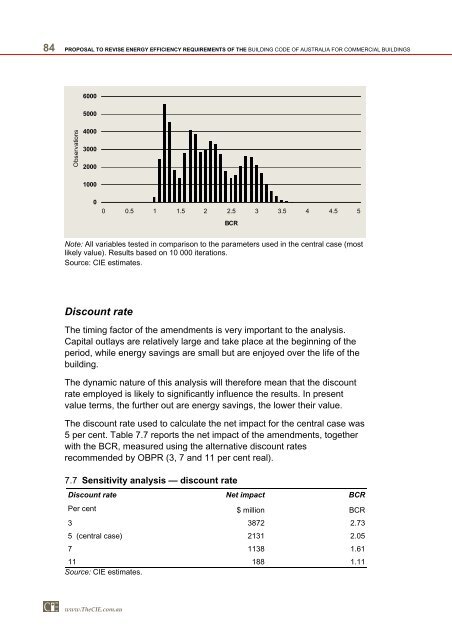PDF | 2 MB - Australian Building Codes Board
PDF | 2 MB - Australian Building Codes Board
PDF | 2 MB - Australian Building Codes Board
You also want an ePaper? Increase the reach of your titles
YUMPU automatically turns print PDFs into web optimized ePapers that Google loves.
84 PROPOSAL TO REVISE ENERGY EFFICIENCY REQUIREMENTS OF THE BUILDING CODE OF AUSTRALIA FOR COMMERCIAL BUILDINGS<br />
6000<br />
5000<br />
Observations<br />
4000<br />
3000<br />
2000<br />
1000<br />
0<br />
0 0.5 1 1.5 2 2.5 3 3.5 4 4.5 5<br />
BCR<br />
Note: All variables tested in comparison to the parameters used in the central case (most <br />
likely value). Results based on 10 000 iterations. <br />
Source: CIE estimates.<br />
Discount rate<br />
The timing factor of the amendments is very important to the analysis.<br />
Capital outlays are relatively large and take place at the beginning of the<br />
period, while energy savings are small but are enjoyed over the life of the<br />
building.<br />
The dynamic nature of this analysis will therefore mean that the discount<br />
rate employed is likely to significantly influence the results. In present<br />
value terms, the further out are energy savings, the lower their value.<br />
The discount rate used to calculate the net impact for the central case was<br />
5 per cent. Table 7.7 reports the net impact of the amendments, together<br />
with the BCR, measured using the alternative discount rates<br />
recommended by OBPR (3, 7 and 11 per cent real).<br />
7.7 Sensitivity analysis — discount rate<br />
Discount rate Net impact BCR<br />
Per cent $ million BCR<br />
3 3872 2.73<br />
5 (central case) 2131 2.05<br />
7 1138 1.61<br />
11 188 1.11<br />
Source: CIE estimates.<br />
www.TheCIE.com.au
















